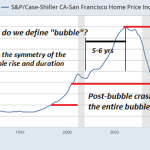For the average person, understanding price charts is hard enough, add multiple time frames to that and things get very confusing, very fast.
Price Charts: Price charts represent the footprints of money, peoples’ buy and sell decisions. Areas on any price chart where you see lots of trading activity suggests relative equilibrium in supply and demand. Areas on the price chart where you see little activity suggests supply and demand are out of balance; this is where price turns.
Time Frames: You can look at a price chart in any time frame you want these days. The purpose of looking at multiple time frames is the same as why a Doctor takes multiple X-rays when looking at a broken arm, for example. The 2 or 3 X-rays will all look different, but it’s still the same arm. Looking at multiple time frames helps us figure out where the real supply/demand imbalance is in a market as that is where price turns, which is where we want to buy and sell.
If you are a short-term trader making buy and sell decisions on a five-minute chart without paying attention to where price is in the larger time frame, my guess is you’re losing money. The key to proper low risk, high reward and high probability trading and investing is having a complete view of both the larger and smaller time frames of the market.
What Are the Benefits of Looking at Multiple Time Frames?
Looking at multiple time frames on price charts allows traders to:
1) know where the current price is at in relation to the larger time frame supply/demand curve which tells us whether price will go up or down (buy or sell).
2) obtain a very low risk/high reward entry into the market by combining larger time frame location with smaller time frame supply and demand levels.
Let’s take a look at a recent trade I took in Gold to illustrate these points.
Gold rallied strong for a couple days prior to me selling short at supply. The news was good, a rally was underway and most people around the world were buying. However, as you can see from the chart below, price had rallied all the way up to a fresh supply level, meaning the likely next move in price was down. This is significant because it is a larger time frame. Also, notice all the room below for price to fall (to the blue line). In other words, with price at supply and little demand below, there was not much to stop Gold from falling.














Leave A Comment